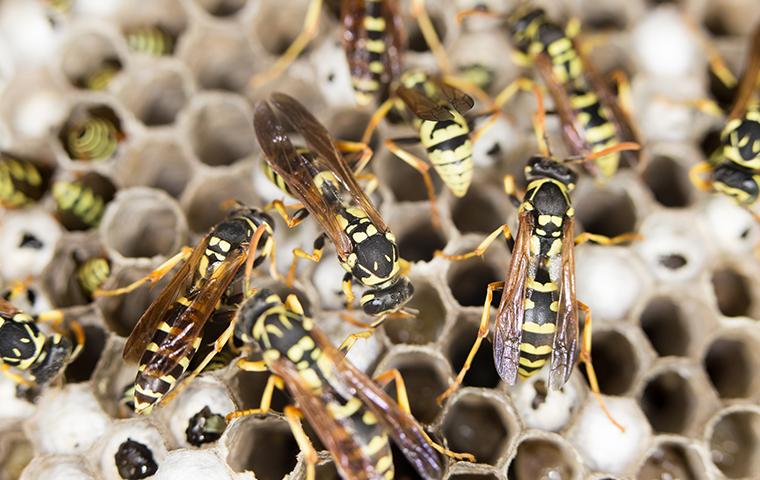Wasps: those buzzing, stinging insects that can quickly turn a pleasant summer afternoon into a frantic retreat indoors. While they play a role in the ecosystem, they’re not welcome guests at our picnics or in our homes. Understanding their behavior, knowing how to prevent them, and having a plan for effective control is key to enjoying a sting-free season.
Know Your Enemy:
Wasps come in various shapes and sizes, each with its own nesting habits and temperament:
- Yellow Jackets: These ground-dwelling or cavity-nesting wasps are notorious for their aggression and painful stings. They’re often attracted to sugary drinks and food scraps, making outdoor dining a challenge.
- Paper Wasps: Less aggressive than yellow jackets, they construct open-celled nests under eaves, branches, and in sheltered areas. While they generally won’t bother you unless provoked, their stings are still painful.
- Mud Daubers: These solitary wasps are non-aggressive and rarely sting. They’re beneficial garden allies, preying on spiders and other insects. Their distinctive mud nests are often found on walls and under eaves.
- Bald-faced Hornets: Though called “hornets,” they’re actually a type of yellow jacket. They build large, enclosed paper nests high in trees or under eaves. They are fiercely protective of their colony and will sting repeatedly if disturbed.
The Sting of the Matter:
Wasp stings are more than just a painful nuisance. For individuals with allergies, a single sting can trigger a life-threatening reaction known as anaphylaxis, requiring immediate medical attention. Even without allergies, multiple stings can cause significant discomfort and swelling.
Why Are They Here?
Wasps are attracted to our properties for a variety of reasons:
- Food: Sweet treats, sugary drinks, and even protein-rich foods like meat scraps can attract wasps.
- Water: Wasps need water for drinking and nest building. Birdbaths, puddles, and leaky faucets can all be appealing.
- Shelter: Overhanging branches, eaves, and gaps in siding provide ideal nesting sites.
- Landscaping: Flowering plants, fruit trees, and dense vegetation can attract foraging wasps.
Winning the Battle:
Prevention is Key:
- Food Management: Keep food covered, clean up spills quickly, and store garbage in tightly sealed containers.
- Water Control: Eliminate standing water sources and repair leaky outdoor faucets.
- Seal Up Your Home: Caulk cracks and crevices in your home’s exterior to prevent wasps from nesting inside.
- Landscaping Strategies: Trim back overgrown vegetation and consider planting wasp-repelling herbs like mint, basil, and geraniums.
Calling in the Professionals:
- Nest Removal: Professional pest control technicians have the expertise and equipment to safely remove wasp nests.
- Targeted Treatments: Professionals can apply insecticides specifically designed to eliminate wasps while minimizing harm to beneficial insects.
- Preventative Measures: Pest control companies can provide ongoing monitoring and preventative treatments to keep your property wasp-free.
Remember:
- Never attempt to remove a wasp nest yourself without proper training and protective gear.
- If stung, monitor for signs of an allergic reaction and seek medical attention if necessary.
By understanding wasp behavior, taking preventative measures, and enlisting professional help when needed, you can reclaim your outdoor spaces and enjoy a worry-free summer.
Don’t Let Wasps Ruin Your Summer!
Take action now to prevent and control wasps around your home. For expert advice in Clinton, IA, La Valle, WI, Springfield, IL, Sycamore, IL, Barrington, IL, Delavan, WI, and the surrounding areas, contact the professionals at Pest Control Consultants (PCC). We have the experience and knowledge to help you win the war against wasps and enjoy a sting-free season. Call us today for a free consultation!
Get help now